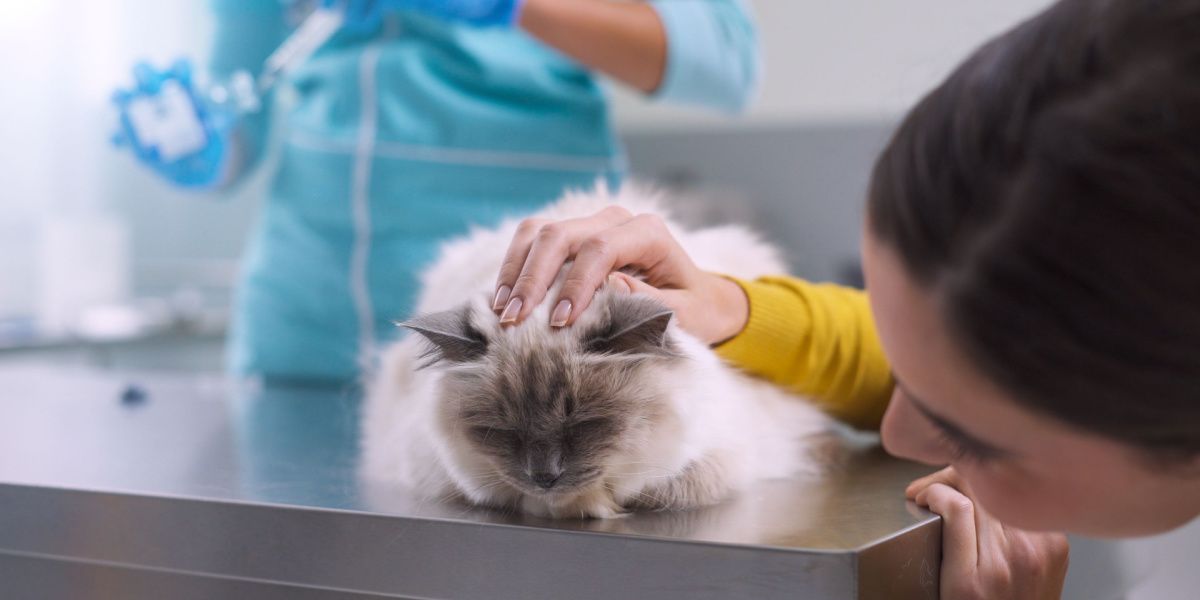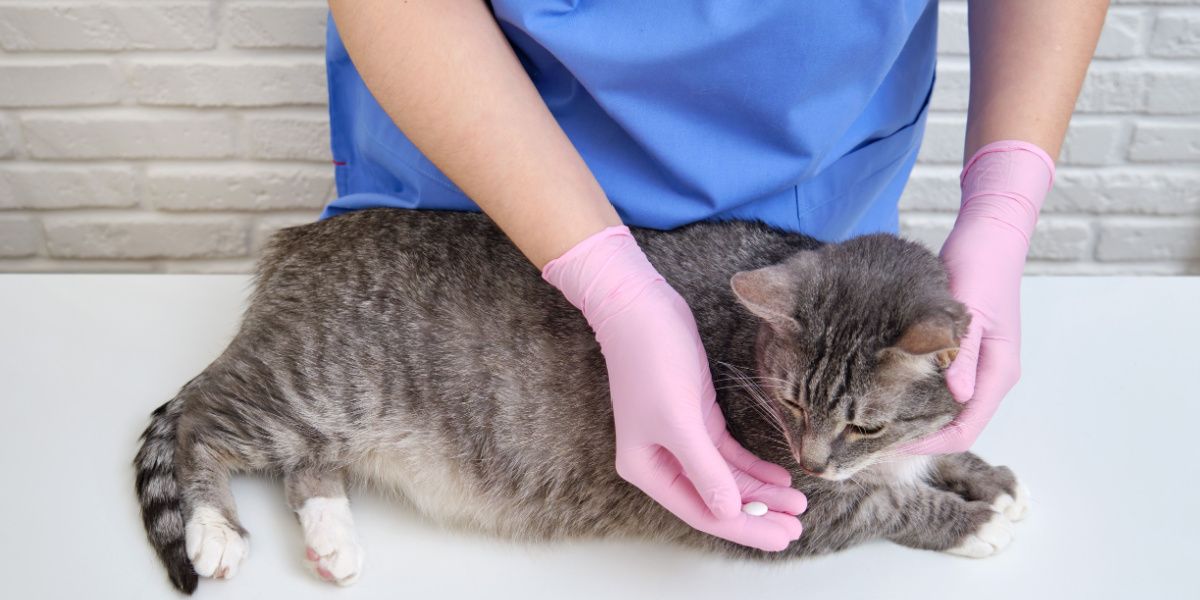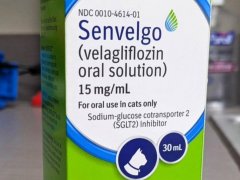
Antibiotics for cats are a crucial tool for treating infections and helping sick cats heal. There are many different classes and types of antibiotics, which can be confusing. Read on to find out how your vet decides which antibiotic to use and when, learn tips for getting your cat to take an antibiotic, what side effects to look out for, and more.
About Antibiotics for Cats
An antibiotic is a medication that has the ability to kill bacteria or stop their growth. Some people believe that antibiotics can be used for any type of infection, but this is incorrect. Infections can also be caused by viruses, fungi, and protozoal organisms, which cannot be treated with antibiotics.
The term antibiotic is reserved for medications used for bacterial infections. Antivirals, antifungals, and antiprotozoals are the types of medications we use for infections caused by the other three classes of microorganisms.
Pet owners with sick cats frequently ask, “Does my cat need an antibiotic?” To answer that question, it’s always important to know if a bacterial infection is actually present versus an infection caused by another organism like a virus. It’s true that some antibiotics might also have activity against one or more of these other types of organisms, but this is the exception rather than the rule and antibiotics should not be used if a bacterial infection is not present.
Common Uses for Antibiotics for Cats
Antibiotics may be used for a wide variety of bacterial infections depending on where they’re located.
Skin infection: A skin infection refers to bacterial overgrowth on the skin that can lead to hair loss, red rashes, and crusty flaky skin among other symptoms. These infections can occur anywhere on the body. Infections caused by fungal yeast are commonly present at the same time.
Urinary tract infection (UTI): The lower urinary tract includes the bladder and urethra, which exits the body. The upper urinary tract includes the kidneys and the tubes that connect them to the bladder called the ureters. Bacterial infections often start in the lower urinary tract but can work their way upward to the kidneys if untreated. Other conditions not caused by bacterial infection, like feline idiopathic cystitis, can often look like a UTI.
Respiratory infection: The upper respiratory tract involves the nose, throat, and upper airway. The lungs compose the lower respiratory tract. Antibiotic choices might be different depending on whether the upper or lower tract is affected. Viral infections in cats caused by feline herpesvirus (FHV) and feline calicivirus (FCV) can often look similar to bacterial infections.
Surgery: There are many surgeries, like a spay (ovariohysterectomy) surgery for example, considered to be sterile procedures. Great attention is taken to ensure the surgery site is free of bacterial growth by removing any fur in the area and prepping with topical antiseptics. However, antibiotics might still be used if an area cannot be cleaned adequately (like a foot) or if there is a high concern for infection after surgery (orthopedic surgeries, gastrointestinal surgeries, and wound repairs).
Gastrointestinal upset: Some diarrhea is caused by overgrowth of detrimental bacteria in the GI tract, like clostridial bacteria or E. coli. This is considered a very common contributing factor to diarrhea in many pets.
Dental infections: Bacteria normally reside in the mouth. Without good dental care, bacteria can cause damage to the gums and their connections to the teeth. Teeth roots can develop infections and abscesses.
Wounds: It is common for cats to get into fights with each other, especially cats that go outdoors. Cats harbor a number of nasty bacteria in their mouths and bite wounds are a common source of infection. Other wounds from other types of trauma can also easily get infected by bacteria from the skin or surrounding environment.
Types of Antibiotics

Different classes of antibiotics treat different types of bacteria.
Instead of specific antibiotics, we’re going to review several classes of antibiotics that are commonly used for cats. Within each class, there are usually a few specific antibiotics that are commonly used.
Penicillins: Amoxicillin, amoxicillin-clavulanate (Clavamox)
Amoxicillin is one of the most widely used antibiotics and is FDA approved for cats. Amoxicillin is indicated for many different types of bacterial infections, including urinary tract infections, respiratory infections, skin infections, and wounds. Amoxicillin-clavulanate (Clavamox) has enhanced ability against additional bacteria regular amoxicillin does not. This makes it a more common choice comparatively.
Cephalosporins: Cephalexin, cefpodoxime, cefovecin sodium (Convenia)
Cephalosporins are most often used for infections of the skin. Cephalexin and cefpodoxime are more often used in dogs and are labeled for them, but can be used off-label in cats. Cefpodoxime might have additional success when used for urinary tract infections.
Because of their small size and notorious difficulty taking an oral tablet, the long-acting injectable Convenia is most commonly used for cats. While only labeled for use against some skin infections and wounds, vets might use it off-label for many types of infections, including those of the urinary tract and respiratory tract. Convenia is given as an injectable under the skin and lasts for two weeks.
Lincosamides: Clindamycin
Clindamycin is commonly used for infections of the skin and mouth and FDA approved for this use in cats. It also has activity against the protozoal organism Toxoplasma gondii that causes toxoplasmosis.
Tetracyclines: Doxycycline
Doxycycline is used in cases of some upper respiratory infections especially when caused by Mycoplasma felis or Chlamydia felis. It is also effective against Bordetella, a cause of kennel cough in dogs, which cats might uncommonly pick up. Doxycycline is the medication of choice for what are called rickettsial bacteria. These types of bacteria are most associated with fleas, ticks, and causes of anemia. These include Mycoplasma haemofelis, echrlichiosis, anaplasmosis, and bartonellosis. Doxycycline might also be used to treat the protozoal organism Toxoplasma gondii that causes toxoplasmosis.
Fluoroquinolones: Enrofloxacin (Baytril), orbifloxacin (Orbax), pradofloxacin (Veraflox), marbofloxacin (Zeniquin)
This class of antibiotics has a broad spectrum of coverage but is considered a higher tier of antibiotic to use. Some veterinarians might reserve use unless another choice, like Convenia or Clavamox, are ineffective. They are used for infections of the skin, urinary tract, respiratory tract or anywhere the bacteria involved are considered susceptible.
Orbax, Veraflox, and Zeniquin all carry labels for use in cats and might to some degree be used interchangeably for similar types of infections.
Baytril has both an injectable and oral form, but only the oral form is approved for use in cats. There is a dose restriction in cats because of concern for side effects, so one of the other fluoroquinolones is usually preferred.
Aminoglycosides: Gentamicin, amikacin
This class of antibiotics is largely only used for injectable treatments and do not have oral forms. They do carry concerns for kidney toxicity and are used rarely in cats unless the risk of a susceptible infection outweighs the risk of side effects.
Gentamicin might also be found in some topical ointment products in combination with an antifungal and steroid. Although toxic effects from this form are unlikely, care should be taken to not let a cat lick an ointment or cream containing gentamicin.
Both amikacin and gentamicin are included in some antimicrobial eye ointments or solutions.
Macrolides: Azithromycin (Zithromax)
Azithromycin has some broad spectrum activity for a variety of infections but is most often used in the case of some upper respiratory infections. Its use is always off-label in cats.
It might be reserved for infections not responsive to other antibiotic choices. Its immune-modulating and anti-inflammatory effects have made it a choice for treating cats with chronic nasal and sinus infections (rhinosinusitis).
Azithromycin has additional activity against Bartonella and some protozoal parasite conditions like toxoplasmosis, cryptosporidiosis, and cytauxzoonosis.
Metronidazole may be used for infections of the gastrointestinal tract. It also is suspected to have an immune-modulating effect to explain its benefit for some causes of diarrhea and some cats with inflammatory bowel disease.
Metronidazole is effective against bacteria that do not require oxygen to thrive, which are called anaerobes. Besides being present in the gastrointestinal tract, anaerobes may also contribute to infections of the liver and gallbladder.
Antibiotic Dose in Cats

Always follow the dosing instructions and finish the medication completely, even if your cat seems to be doing better after a few days.
Antibiotic dosing can vary a great deal depending on the antibiotic being used and the type of infection being treated. Some antibiotics are labeled for cats and have a specific FDA-approved dose to use, but it might still be a different dose or length of time depending on the reason for use.
Other antibiotics might not have a label for use in cats but might still be prescribed by a veterinarian if indicated. This is called off-label use and is very common in veterinary medicine. In these cases, vets determine dose based on drug formularies and published research.
Because of a high concern about bacterial resistance to antibiotics and inappropriate use of them, the determination to use an antibiotic is at the discretion of a veterinarian. In many cases, your vet will require that your cat be examined to confirm a bacterial infection is present. Sometimes extra testing might be needed, such as a urine sample, stool sample, or microscope slide impression of the skin to verify bacterial presence.
Although less common, your vet might want to collect a bacterial culture if there is concern that bacterial resistance to antibiotics is involved. A bacterial culture helps determine what specific bacterial strain is present and what antibiotics to use.
How To Administer an Antibiotic to Cats
Many antibiotics are given orally by mouth. They can come in tablet, capsule, or liquid form.
For some antibiotics, like clindamycin or amoxicillin, a tablet or liquid form is available for both. In this case, your vet might have you choose which form will be easier to give your cat.
For some other antibiotics, like doxycycline, a tablet form is the only type commercially available.
Antibiotics are most often given with food unless you are directed otherwise by your vet. This helps with absorption of the antibiotic by the body. It also helps reduce the chance of stomach upset.
For tablets and capsules, it can be helpful to try hiding an antibiotic in food or a treat. Here are some cats foods that might work best for medicating your cat.
If hiding medication in food is not working well, you might need to give an antibiotic to your cat directly by mouth. This can be a little daunting, but here are some tips to help give oral medication to your cat.
In some cases, if an antibiotic doesn’t come in a liquid form normally and this form will work better for your cat, your vet might be able to order a liquid form through a compounding pharmacy. Doxycycline is a great example of where this might be necessary. Compounding pharmacies can also help make flavored tablets or chewable medications.
Common Side Effects of Antibiotics in Cats
Many cats do very well with antibiotics and don’t show significant side effects. Their infection is gone and they feel better!
But some side effects are common to see. These are usually associated with gastrointestinal upset, digestion, and appetite:
- Vomiting
- Diarrhea
- Decrease in appetite
- Excessive salivation (especially right after giving a pill by mouth)
These types of side effects are important to let your vet know about. Depending on how important the antibiotic treatment is and the severity of the side effects, your vet might either prescribe other medications to help with the side effect symptoms, or advise discontinuing the antibiotic.
Uncommon Side Effects

Although rare, some cats experience serious side effects from antibiotics, including fever, hives or difficulty breathing.
More serious side effects are considered very rare but might include:
- Hives
- Skin irritation or itching
- Breathing difficulty
- Fever
If you see any side effects like these, make an immediate visit to your vet or nearest emergency veterinary hospital.
If you have concern about seeing side effects after giving your cat an antibiotic dose, or if you have concern about an overdose, make sure to contact:
- Your veterinarian
- ASPCA Animal Poison Control Center (1-888-426-4435)
- Pet Poison Helpline (1-855-764-7661)
Drug Dosing Disclaimer: We are only able to provide doses for medications that are FDA approved for use in cats and only as the label guidelines dictate. For medications that are used off-label we can only provide guidelines and safety information for use. Safe and appropriate dosing for off-label medications can only be determined by a primary care veterinarian.
We encourage you to work with your veterinarian to determine if a particular medication is appropriate for your cat. Changing or adjusting a dose for your cat on your own without consulting with a veterinarian can carry risk. We do not encourage use of medications prescribed for human use in pets without first consulting with a primary care veterinarian.
Frequently Asked Questions
Can I get antibiotics for my cat without seeing my vet?
Generally not. There are many conditions that can closely mimic a bacterial infection. Examples include viral upper respiratory infections and stress-related inappropriate urinary behavior. Your vet will look to confirm a bacterial infection is present before prescribing antibiotics and this often requires an exam and sometimes additional testing.
Although fish amoxicillin can be purchased over-the-counter and some people feel this is an easy workaround, this is inappropriate and not safe for cats. This form of amoxicillin is not intended for oral ingestion and there is less stringent quality control or regulation involved with its manufacture.
Can I give my cat my own antibiotics?
You should not give your cat your own antibiotics. Some antibiotics used for people might not be safe or appropriate for cats. The antibiotic dose for a person is often be higher than what a cat would require, and giving your own antibiotic dose might lead to more pronounced side effects. You also don’t know that the antibiotic you have is appropriate for the type of infection your cat has. Your cat might also not have a bacterial infection and might require a different treatment altogether.
Will antibiotics help a sick cat?
Antibiotics will help a sick cat if that cat has a bacterial infection. The antibiotic must also be appropriate for the type of bacterial infection a cat has.
What if I miss a dose of an antibiotic for my cat?
If you miss a dose of antibiotic for your cat, try to give the next dose as close to when it was due as possible. For example, if you miss a dose of a 12-hour antibiotic by an hour or two, it might still be best to give that dose . However, if you’ve missed that dose by six or eight hours, it might be better to wait and give the next dose when it is due.
If giving a 24-hour antibiotic, still consider giving a missed dose unless it is more than eight to 12 hours overdue. If you missed giving it in the morning and give the next dose that night, continue giving future doses once a day at night instead.








If my cats are prescribed very small pills, I call our compounding pharmacy and buy empty capsules. You will need to buy a capsule that the pill fits, then load the pills into the capsules. Capsules are much easier to use when pilling a cat as they are larger, they also go down better.
My cats all get Cosequin, I bought the sprinkle capsules so I recycle those for use with small pills. I wish I would have figured this out sooner and I really hope it helps some of your readers.
If they don’t use Cosequin, or don’t have a willing compounding pharmacy, they can order online. Make sure you know what size you need, if you order the wrong size, don’t worry, I purchased 100 empty capsules for three dollars.